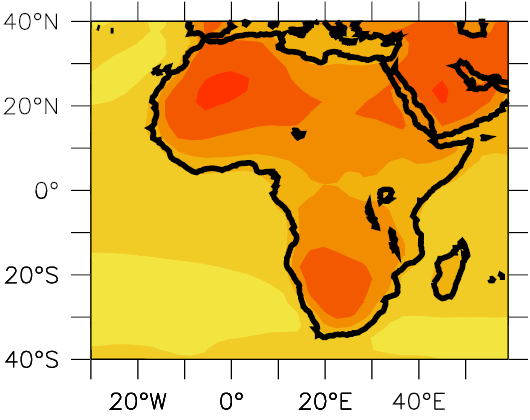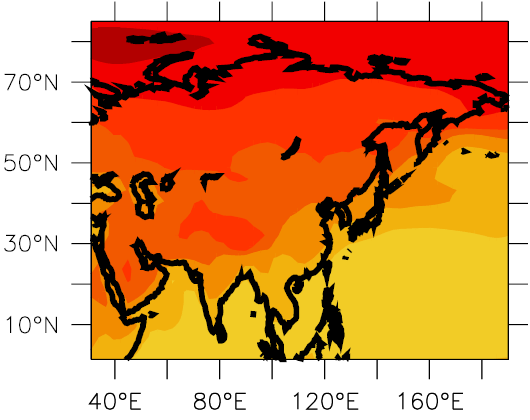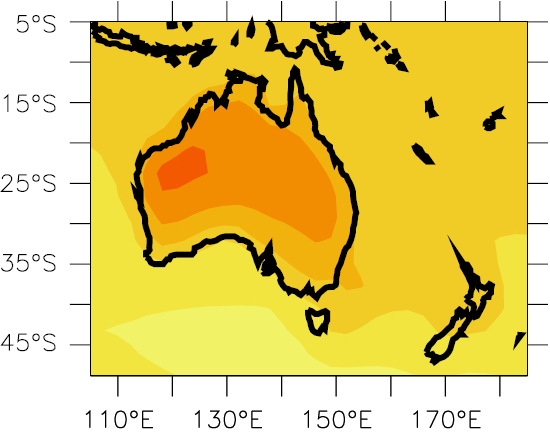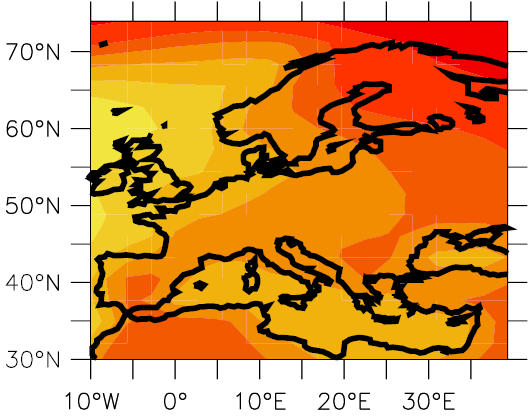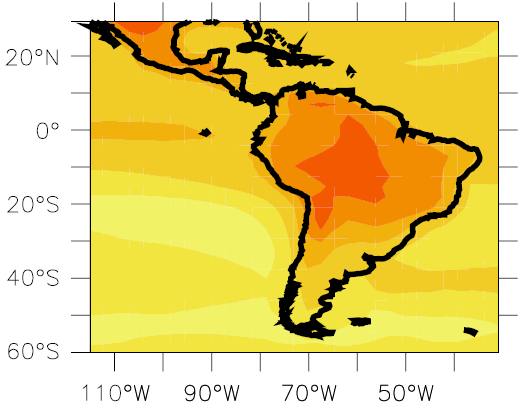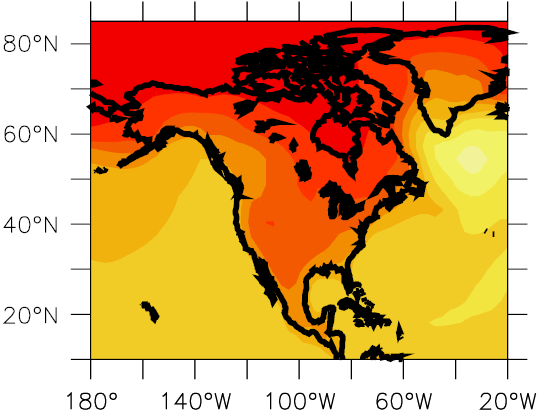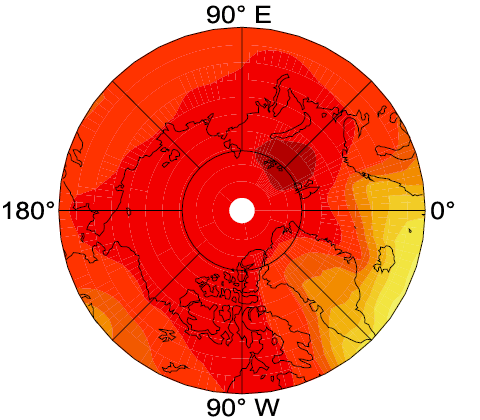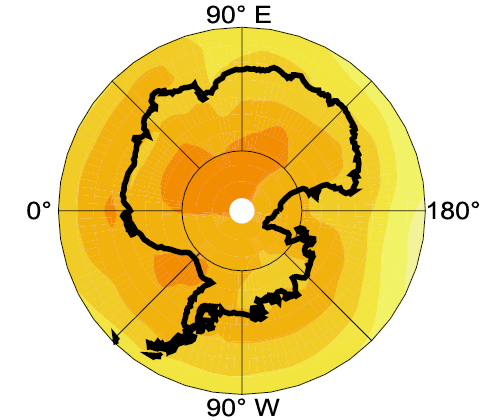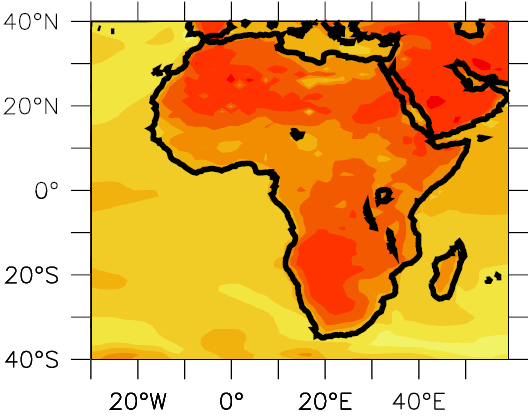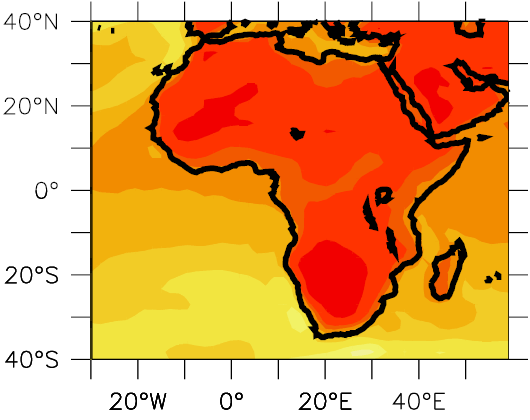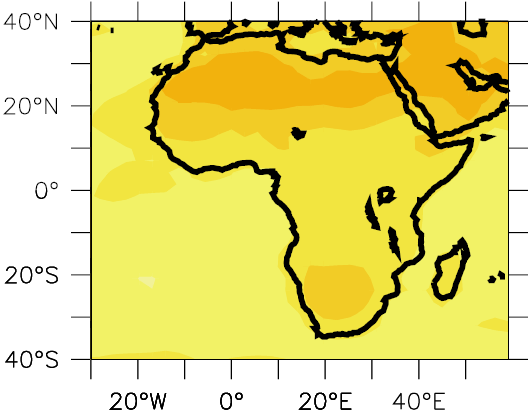Modeling Future Climate on a Regional Scale
Before we dive into understanding how climate will change in Africa, Asia, and other places, let's think about how climate change is not equal in all areas of the world. Take a look at the maps below with the following questions in mind.
- Will there be more warming over oceans or over land, or will land and sea heat equally?
- Is the projected temperature increase the same at all latitudes, or is there some difference between the tropics, mid-latitudes, and/or polar regions?
- Is the temperature rise in the Southern Hemisphere likely to be similar to or different from the change in the Northern Hemisphere?
- Will coastal regions or areas that are far inland on continents warm more? Or will coasts and landlocked regions warm by similar amounts?
| |
Years |
2020-2029 |
2090-2099 |
| Scenario B1 |

Avg. Global Temp = 0.76° C above 1980-1999 |

Avg. Global Temp = 1.85° C above 1980-1999 |
| Scenario A2 |
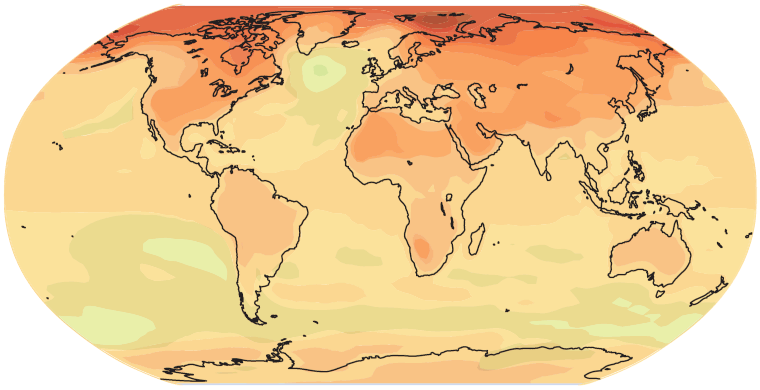
Avg. Global Temp = 0.77° C above 1980-1999 |
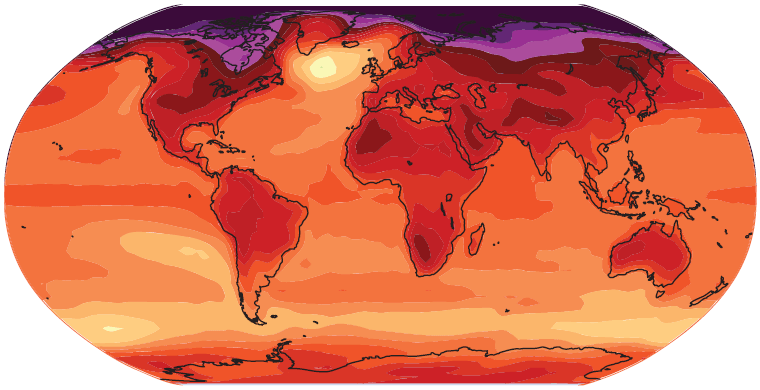
Avg. Global Temp = 3.34° C above 1980-1999 |
| |
 |
| These images, based on climate model results, show predictions of the amount of change in temperature as compared to average temperatures for the period from 1980 to 1999. Green and yellow indicate smaller temperature increases, while red and purple indicate larger increases. The two maps on the left show projections for years 2020 to 2029. The maps on the right show projections for the years 2090 to 2099. The top maps show predictions based on the relatively optimistic IPCC B1 scenario. The lower maps are predictions based on the relatively pessimistic IPCC A2 scenario. |
As you can see in the maps above, global warming will not have the same impacts everywhere. As climate warms, scientists expect:
- The oceans are expected to warm more slowly than land due to the vast thermal inertia of water, and areas above oceans are expected to warm more slowly than land too. We have already seen this trend during the 20th Century.
- High latitudes, especially in and around the Arctic, will warm more than places closer to the equator. Climate scientists generally expect the Arctic to heat up about twice as quickly as compared to the global average temperature. So far, the Arctic has warmed much faster than other areas.
- In general, the middle of continents are expected to warm more than coastal areas. Regional topography such as mountain ranges will influence this too.
When it comes to climate change, it's all about location, location, location...
The information below explains how climate change is expected to affect different parts of the world. While this table is convenient for printing, we have a couple of other ways for you to explore the same information online. Take a look at this information with related precipitation maps in the Explore Regional Climate Change interactive. Alternatively, you may like to compare some of these regional temperature and precipitation maps side-by-side.
Africa
- 75 and 250 million of people are projected to be exposed to increased water stress due to climate change by 2020.
- Yields from rain-fed agriculture could be reduced by up to 50% in some countries by 2020. This would make limit access to food in many African countries, adversely affecting food security and exacerbating malnutrition.
- Towards the end of the 21st Century, projected sea level rise will affect low-lying coastal areas with large populations. The cost of adaptation could amount to at least 5 to 10% of Gross Domestic Product (GDP).
- The amount of arid and semi-arid land is projected to increase by 5 to 8%.
|
Asia
-
Freshwater availability in Central, South, East and South-East Asia, particularly in large river basins, is projected to decrease by the 2050s.
- Coastal areas, especially heavily populated delta regions in South, East and South-East Asia, will have a greater risk of flooding from rising sea level and, in some deltas, from river flooding.
- Climate change is projected to compound the pressures on natural resources and the environment associated with rapid urbanization, industrialization and economic development.
- Changes in the water cycle are expected to cause more diarrhea disease associated with floods and droughts in East, South and South-East Asia.
|
Australia and New Zealand
-
By 2020, significant loss of biodiversity is projected to occur in some ecologically rich sites, including the
Great Barrier Reef and Queensland Wet Tropics.
- Less water, more drought and fire are expected to decrease production from agriculture and forestry over much of southern and eastern Australia, and parts of eastern New Zealand by 2030.
New Zealand, initial benefits are projected in some other regions.
- By 2050, ongoing coastal development and population growth in some areas of Australia and New Zealand are projected to exacerbate risks from sea level rise and increases in the severity and frequency of storms and coastal flooding.
|
Europe
-
Climate change is expected to magnify regional differences in Europe’s natural resources and assets.
Inland flash floods are projected to become more common as are coastal flooding and erosion (due to storminess and sea level rise).
- Mountainous areas will face glacier retreat, reduced snow cover and winter tourism, and extensive species
losses (up to 60% by 2080 in some areas).
- In southern Europe, climate change is projected cause higher temperatures and drought, reduced water availability, hydropower potential,
summer tourism, and crop productivity.
- Climate change is also projected to increase the health risks due to heat waves and the frequency of wildfires.
|
Latin America
-
By mid-century, increases in temperature and associated decreases in soil water are projected to lead to gradual replacement of tropical forest by savanna in eastern Amazonia. Semi-arid vegetation will tend to be replaced by arid-land vegetation.
- There is a risk of significant biodiversity loss through species extinction in many areas of tropical Latin America.
- Productivity of some important crops is projected to decrease and livestock productivity to decline, with adverse consequences for food security. In temperate zones, soybean yields are projected to increase. Overall, the number of people at risk of hunger is projected to increase.
- Changes in precipitation patterns and the disappearance of glaciers are projected to significantly affect water availability for human consumption, agriculture and energy generation.
|
North America
-
Warming in western mountains is projected to decrease snowpack, increasing flooding of rivers in winter and reducing their summer flows.
- In the early decades of the century, moderate climate change is projected to increase yields of rain-fed agriculture by 5 to 20%, but with important variability among regions. Major challenges are projected for crops that are near the warm end of their suitable range or which depend on highly utilized water resources.
- Cities that currently experience heat waves are expected to get an increased number of more intense and longer heat waves.
- Coastal communities and habitats will be increasingly stressed by climate change impacts interacting with development and pollution.
|
Polar Regions
- The thickness and extent of glaciers, ice sheets and sea ice will be reduced. This will cause changes in ecosystems with detrimental impacts on many species including birds, mammals and higher predators.
- Impacts on human communities in the Arctic are projected to be mixed. Less snow and ice is expected to have a detrimental impact on infrastructure and traditional indigenous ways of life.
- Polar ecosystems are projected to become more vulnerable, as climate barriers to species invasions are lowered.
|
Small Islands
- Sea level rise is expected to increase the amount of storm surge flooding, erosion and other coastal hazards. This will threaten infrastructure, settlements and facilities that support the livelihood of island communities.
- Deterioration in coastal conditions, for example through erosion of beaches and coral bleaching, is expected to affect local resources.
- By mid-century, climate change is expected to reduce freshwater in many small islands in the Caribbean and Pacific to the point where there is not enough water to support the population.
- Invasion of non-native species is expected to occur, particularly on mid- and high-latitude islands.
|
A note about accuracy of regional climate predictions:
The images to the right show modeled temperatures for Africa from three different climate models and an average of 21 different models. There are similarities in the locations of warmer and not-quite-so-warm regions. There are also differences between the models.
Predicting future climate for specific geographical regions is a tricky business. Scientists are still working to make more accurate predictions of how the climate of specific regions is likely to change. For now, these predictions have a broad range of uncertainty. However, with bigger and faster supercomputers and improved models, our ability to model climate on a regional basis is sure to improve in the coming years.
Last modified May 26, 2009 by Lisa Gardiner.
You might also be interested in:
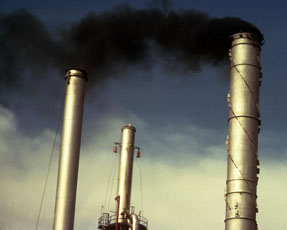
Leaders from 192 nations of the world are trying to make an agreement about how to limit emissions of heat-trapping greenhouse gases, mitigate climate change, and adapt to changing environmental conditions.
...more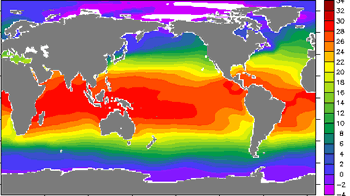
Climate in your place on the globe is called regional climate. It is the average weather pattern in a place over more than thirty years, including the variations in seasons. To describe the regional climate
...more
Less than 1% of the gases in Earth's atmosphere are called greenhouse gases. Even though they are not very abundant, these greenhouse gases have a major effect. Carbon dioxide (CO2), water vapor (H2O),
...more
Television weather forecasts in the space age routinely feature satellite views of cloud cover. Cameras and other instruments on spacecraft provide many types of valuable data about Earth's atmosphere
...more
Predicting how our climate will change in the next century or beyond requires tools for assessing how planet responds to change. Global climate models, which are run on some of the world's fastest supercomputers,
...more
The world's surface air temperature increased an average of 0.6° Celsius (1.1°F) during the last century according to the Intergovernmental Panel on Climate Change (IPCC). This may not sound like very
...more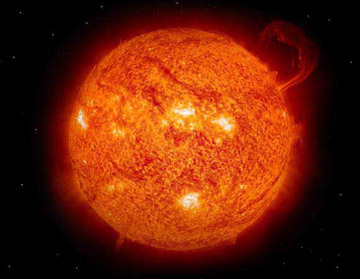
A factor that has an affect on climate is called a “forcing.” Some forcings, like volcanic eruptions and changes in the amount of solar energy, are natural. Others, like the addition of greenhouse gases
...more







